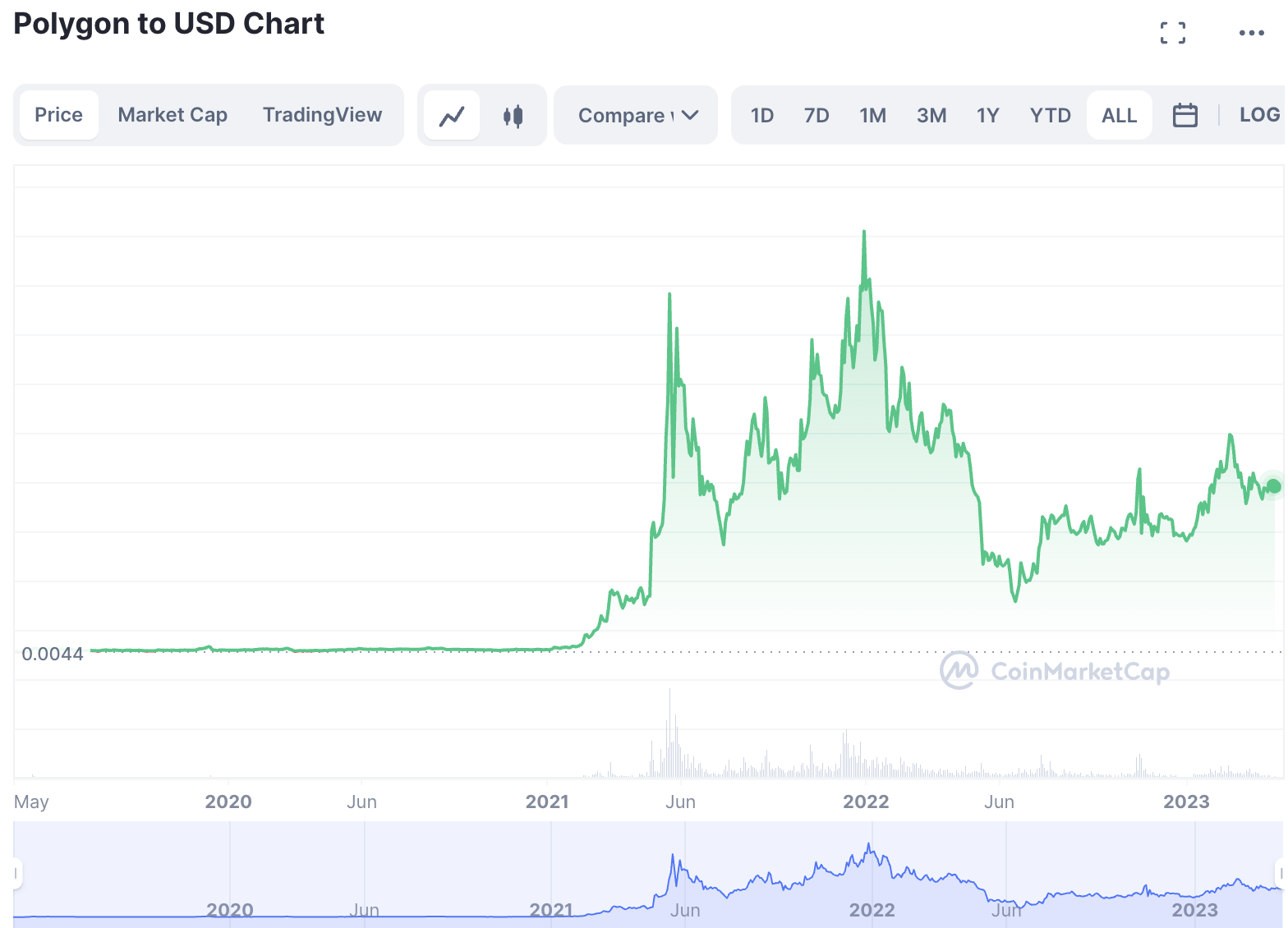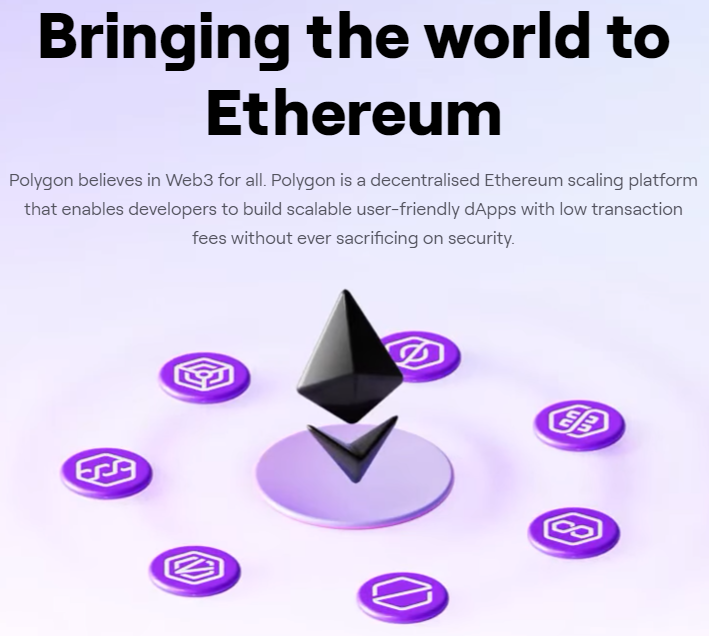Polygon envisions popularizing the Ethereum platform by offering a Layer-2 scaling solution. This solution is geared towards developers who are in need of a secure and accessible platform to build decentralized applications (dApps) with enhanced scalability. The ecosystem of Polygon utilizes its native token, MATIC, which plays a crucial role in various aspects of the network.
Despite recent roadmap updates and upgrades, the Polygon price (its native coin MATIC) corrected over 30% last year, opening the year and trading in the $0.7 – $0.8 range. Since then, however, it has continued to show a promising uptrend this year. Will Polygon coin go up in 2025? Is MATIC a good investment? This guide will forecast the polygon MATIC’s price until 2030.
Polygon Price Prediction – Overview
A summary of our MATIC prediction for the near future is presented below to provide a general understanding of the coin’s potential value:
- By 2024: Given MATIC’s sustained growth and in-network developments, the coin may reach $4 by the end of 2024.
- By 2025: After a choppy movement, if MATIC manages to break through, a path to $6 could be clear by 2025’s end.
- By 2030: With growing crypto acceptance, interest from institutional and retail investors is likely to rise. Furthermore, the broader adoption of layer 2 blockchains in the years to come may push MATIC to $14 by 2030.
Polygon – Latest News
Polygon has been active in making partnerships across the crypto industry and stayed up to date with blockchain tech trends. Recent Polygon news announcements included these updates:
- The Polygon network recently underwent a significant event, the hard fork upgrade, that its community eagerly awaited. This upgrade aimed to mitigate the spike in gas fees and disruptions caused by chain reorganizations.
- In the last quarter, Polygon’s partnership with Nubank, backed by legendary investor Warren Buffet, has sparked positive reactions among stakeholders and is seen as a substantial development for the network.
- Fractal, the NFT platform focused on gaming created by Justin Kan, co-founder of Twitch, is looking to increase its reach by incorporating the Polygon network. This move aims to enhance the platform’s accessibility to users.
| ⧉ Coin Name | Polygon |
| 💲 Price | $0.3994538 |
| 🔆 Coin Symbol | MATIC |
| ⏳ Price Change 1h | 0.3% |
| 🌕 Price Change 24h | 2.56% |
| 💵 Market Cap | $764,468,165 |
| 🥇 Rank | 105 |
| 🌐 24h Volume | $7,101,671 |
| 🔄 Circulating Supply | 1,913,783,718 |
| 💰 Total Supply | 10,000,000,000 |
Polygon Price History
Since its launch in 2017, the MATIC project (which rebranded to Polygon in February 2021 for more global brand recognition) is up over 100,000%. Its native cryptocurrency still has the ticker symbol MATIC. The initial price of MATIC coin was $0.002, when it started trading on cryptocurrency exchanges.

In 2021, MATIC had one of its strongest years. The token soared from a price of $0.0175 to $2.5, equating to a price jump of more than 14,000%. The MATIC bull run coincided with the overall bullishness in the cryptocurrency space, which saw the total crypto market cap rise to $3 trillion, following the success of Bitcoin and Ethereum.
However, the token corrected in 2022, from a price of $2.50 to $0.76.
Since the start of the year, the token has moved from the $0.76 mark to a current price of $1.12 per token. At present moment, Polygon has a market cap of $11.2 billion.
Polygon Price Summary
- MATIC began trading at $0.002 when it went live in 2017.
- In 2021, the token grew by more than 14,000%. The token reached an all-time high of $2.92.
- MATIC corrected down to $0.76 by the end of 2022.
- Currently, the token is trading at $1.12, with a market cap of more than $11.2 billion.
MATIC Price Prediction 2024
In the bullish case for Polygon, the next Bitcoin halving is in 2024, and the previous halving sparked the Bitcoin bull run to $69k from $10k. The total crypto markets also rose in valuation to $3 trillion, increasing the USDT prices of most major blue chip altcoins.
Polygon has also recently allocated $1 billion and successfully secured an additional $450 million to concentrate on various ZK-scaling initiatives. This approach permits various teams to test scaling techniques while promoting close collaboration and exchanging information.
Thus, the medium-term outlook for MATIC appears to be positive. The coin may sustain its upward trajectory toward the $4 level with a few temporary declines.
MATIC Price Prediction 2025
Several experts have diverse opinions regarding the consequences of the eagerly awaited Ethereum merger set to occur next month. Some think that once ETH 2.0 is launched, it may render scaling solutions irrelevant or of reduced significance.
On the other hand, a segment of experts contends that the merger will enhance Ethereum’s eco-friendliness by lowering energy usage, thus making layer 2 scaling solutions like Polygon more attractive to investors as an environmentally conscious crypto option. Additionally, MATIC is expected to experience a surge in value since the Ethereum merger will not impact its controversial high gas fees, highlighting Polygon’s utility.
All in all, it appears that XRP has a promising future ahead, and our XRP price forecast for 2025 predicts that the coin could attain a value of $6.
MATIC Price Prediction 2030
The most optimistic investors in Polygon speculate that it could one day flip Ethereum. That may not be realistic however, it’s based on the high gas fees of Ethereum. Polygon has lower transaction costs.
While at one point, Ethereum had a high, almost 100% dominance across the DeFi space, that has increasingly been reduced by the rise of Layer-2 DeFi projects like Polygon, Solana, Polkadot, and others.
The key elements that will impact MATIC’s price in the upcoming years include the effective implementation of zero-knowledge EVMs, expansion into new blockchain systems, and the rise in the number of dApps hosted on the network. keeping these factors in mind, MATIC could continue its path forward and enter the $10-$14 range.
Potential Highs & Lows of MATIC
The table below summarizes our MATIC price prediction for the years ahead:
Year
Potential High
Potential Low
2024
$4
$2.5
2025
$6
$3
2030
$14
$10
What is Driving the Price of Polygon?
Recent Polygon price changes were likely to be triggered by news and media announcements:
- 29 December 2021 – Polygon revealed that two white hat hackers had exposed a critical network vulnerability which it then fixed on 3 December. Polygon said the malicious hacker was able to steal more than 800,000 MATIC tokens before the network upgrade took effect. It added that it had paid around $3.46 million as a bounty to the two white hats who helped discover the bug.
- 10 January 2022 – Polygon revealed Plonky2, what it called a major milestone for zero-knowledge cryptography. Plonky2 is a recursive SNARK (a cryptographic proof that one user has some specific information without having to reveal what that information is) that is ‘100x faster than existing alternatives and natively compatible with Ethereum.’
- 27 January 2022– Polygon revealed that in December it had over 7000 dApps active on the MATIC network, twice the amount of three months before. It stated that after increasing congestion on the Ethereum blockchain and high gas fees, many DeFi and non-fungible token (NFT) projects had moved over the Polygon blockchain instead.
- 7 February 2022 – Polygon raised a $450m war chest through a private sale of its MATIC tokens to pave the way for the mass adoption of Web3 applications. The founding round was led by Sequoia Capital India and included over 30 other investors such as SoftBank Vision Fund 2, Galaxy Digital, Galaxy Interactive, and Tiger Global. It said the funds will also allow it to continue investing in zero knowledge (ZK) technology that it said ‘will be key to onboarding the next billion users to Web3.’
- 23 February – Wirex, a payments platform and non-custodial cryptocurrency wallet, announced it is going live on Polygon ‘to bring low fees and high transaction speeds to more than 4.5 million users across its ecosystem.’ Wirex customers in 130 countries can use the mobile app to store their cryptos.
- 10 October 2022 – Polygon announced the public testnet launch of its zero-knowledge Ethereum Virtual Machine. October turned out to be a bullish month for MATIC, as the token soared by over 16%.
- February 2025 – Recent on-chain data revealed, however, revealed that top whales are contributing to the selling pressure. The price may continue to slump if the whales continue their selling spree. Investors must pay close attention to the macroeconomic conditions affecting the altcoin market to gauge the chances of a strong recovery.
Polygon vs Ethereum
Polygon exists above Ethereum as a Layer 2 blockchain. The Ethereum blockchain lying below is the one that ultimately secures and processes transactions -but to increase the number of transactions per second that a network can process, developers are now also designing secondary layers on top of existing blockchains.
Also being called the ‘Internet of Blockchains’, the aim of Polygon is to connect various blockchain projects on Ethereum. All these projects have different features but they aren’t necessarily interoperable. Polygon is not the only one attempting that use case – there are other projects moving in the same direction, like Polkadot and Cosmos. By being compatible with Ethereum, Polygon aims to improve upon it and eventually tap into the second-largest blockchain’s ecosystem and security.
To simultaneously secure the network as well as mint new coins with time, Polygon uses the proof-of-stake consensus algorithm. This method requires users to lock up their tokens so that they can be nominated randomly to validate new blocks of data.
Future of Polygon – What’s Next for MATIC?
The Polygon Network has transformed decentralized finance (DeFi) and NFTs because it is a fast, efficient, and cheap scaling solution for the Ethereum blockchain. It has simplified and amplified access to NFTs, some of which are Polygon based NFTs.
As more people venture into DeFi and NFTs, the Polygon user base will expand due to its cheap transaction fees. This surge in onboarding will be through L2 networks like Polygon, as institutions begin building on them. The biggest NFT marketplace, Opensea, has over 350,000 total accounts registered on it. The potential number of market participants for NFTs is much higher.
One of the biggest downsides of the Ethereum network, which often turns potential buyers away, is the transaction fees. L2 solutions to gas fees were inevitable.
Even Coinbase has now launched its own NFT Marketplace, ‘Coinbase NFT’, and may support the Polygon Network. After Coinbase’s venture capital investment in Polygon, an announcement of integrating Polygon for trading was made.
To beat the short term price volatility, you can earn up to 16% interest on your MATIC holdings on Nexo, as well as interest on BTC, ETH, and other cryptos.
Is Polygon the Best Coin to Buy in 2025?
While Polygon is one of the biggest altcoins in the space, we recommend meme coins as a better investment for their higher upside potential than an asset like MATIC with a market cap in the billions.
Love Hate Inu – Leading Memecoin to Invest in Right Now
Love Hate Inu is a memecoin project with a social utility that leverages a Vote2Earn system to create a one-of-a-kind blockchain initiative that rewards people who vote on social causes.
At the center of this project lies the LHINU that users must stake to vote. Since staking is used for voting, Love Hate Inu keeps the voting decentralized and democratized while ensuring that all who vote can reap rewards.
The ecosystem is divided into three systems:
The Voting System is the highlight of Love Hate Inu. It is a staking-enabled voting mechanic where users can stake a number of tokens to cast their votes. Much like other DAO projects, voting power is determined by the number of tokens staked. However, staking duration is another determining factor in this equation.
The Polling System allows users to create their own polls. Users can use the on-boarded tools to create quirky imagery to create “love it and hate it” polls. The polling system has many utilities for brands who want to create sponsored polls – that’s approach would change the way of interacting with the audience.
Poll Management Dashboard is the final element of the equation. It is a dashboard on which users can see their polls and the votes they have gotten. This poll monitoring unit is great for ensuring that the voting process is fresh and the whales aren’t controlling the narrative.
Love Hate Inu recently organized an AMA with its new CEO Carl Dawkins, and has gained ground quickly – in just over a month, the project has raised 70% of its hard cap.
$LHINU Tokenomics
At the center of the Love Hate Inu is LHINU tokens. It is an ERC-20 asset with a total supply of 100 billion. It is a deflationary crypto that has dedicated 90% of its total supply to the presale. the remaining 10% is to provide liquidity for when the listing date arrives.
Presale Started
8 March 2023
Purchase Methods
ETH, USDT
Chain
Ethereum
Min Investment
None
Max Investment
None
Conclusion
Many investors have made bullish Polygon price predictions of up to $10 and even beyond, although its 60% correction since its last ATH could continue in the short-term.
Keep a diversified portfolio and split your crypto investment funds up into several projects. Partly the major blue chip cryptos like BTC and ETH, partly middle range projects like Solana and Polygon, and partly low market cap coins that are early in their roadmap.
In addition to Polygon, Love Hate Inu (LHINU) is a popular new cryptocurrency project to invest in right now audited by CertiK and still in the mid stages of its presale.
Wall Street Memes (WSM) - Newest Meme Coin
- Community of 1 Million Followers
- Experienced NFT Project Founders
- Listed On OKX
- Staking Rewards
FAQs
What is Polygon?
What was the starting price of MATIC?
How high can MATIC go?
Should I buy Polygon?
What will Polygon be worth in 2025?
Is MATIC on Binance?
Is MATIC on Coinbase?
Read More:

